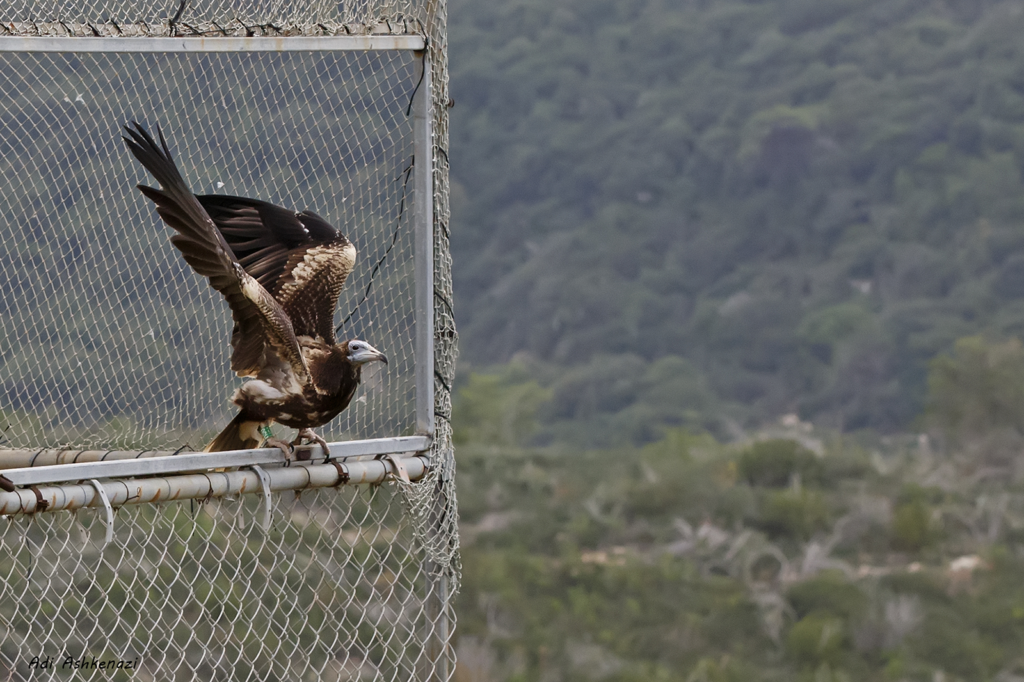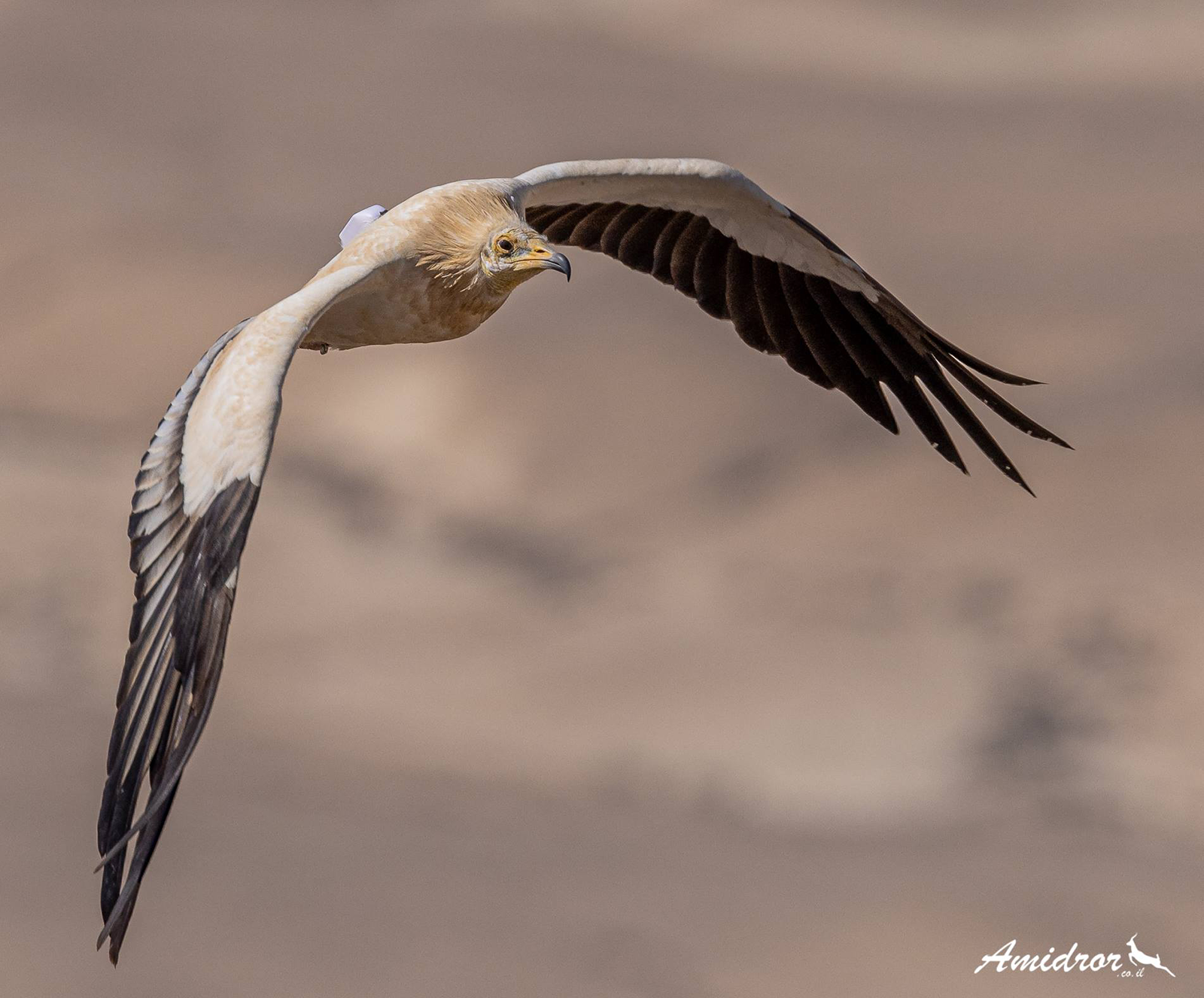By Ron Efrat
Linked Paper: Postrelease survival of captive-bred Egyptian Vultures is similar to that of wild-hatched Egyptian Vultures and is not affected by release age or season by Ron Efrat, Ohad Hatzofe, Ygal Miller, Thomas Mueller, Nir Sapir, and Oded Berger-Tal. Ornithological Applications.
Conservation projects are often lengthy processes that can be difficult to implement and require a long time before results are identifiable. One of the challenges of conservation efforts is to quantify their success following implementation. Such is the case in the reintroduction of the Egyptian Vulture (Neophron percnopterus) in Israel.
Egyptian Vultures are widely distributed small scavengers, with migrating populations in the north of their distribution. These vultures have a unique appearance: Their adult black-and-white feathers are only absent from their yellow head and their long and narrow bill. The high sociality of the species, which often means that it is observed in large groups, can give the false impression that there are many Egyptian Vultures where it is found, but the truth is more discouraging. The species is considered Endangered worldwide, following a major decline in population size due to poisoning, electrocution, habitat loss, and other anthropogenic effects. In Israel, the vulture is considered locally Critically Endangered, with only about 50 breeding pairs remaining.
Since 2005, Egyptian Vultures have been captive-bred and reintroduced in northern Israel. The vultures are released in an area that, until the 1960’s, hosted a breeding colony for Egyptian Vultures and other scavengers. To assess the success of this project, the released vultures are monitored using various methods, which we used in this study to quantify their post-release survival.
Multiple conservation efforts are being carried out throughout the Egyptian Vulture distribution in order to reverse its negative population trend. Among these conservation efforts are reintroduction projects in Italy, Bulgaria, and Israel. In Israel, between 2005–2020, 82 captive-bred Egyptian Vultures were released to the wild in northern Israel. To measure the success of the project, we set out to test whether the monitoring scheme of the project worked, whether the survival of the released birds was affected by release protocols, and whether captive-bred Egyptian Vultures survived as well as Egyptian Vultures that hatched in the wild in Israel.
During the project’s 15 years, the vultures were monitored using two main methods. At first, and throughout the years, the vultures were searched for on a weekly survey around the release area. Before their release, individual vultures were fitted with a unique color ring (band) that was later used for visual identification. Some of the vultures were also fitted with a unique wing tag, and others with a VHF transmitter (radio-telemetry). Starting in 2013, GPS transmitters that were attached to 46 of the vultures provided location data, usually every few hours. In our analyses, we found that GPS transmitters are extremely important for the monitoring of this highly mobile species. First, 31 of the 82 vultures were never visually observed, and wing-tags or VHF transmitters did not improve this finding. On the other hand, all GPS-tagged vultures provided locations. When we compared the time that passed between a vulture’s release date and the last data obtained for that vulture, we found that GPS transmitters provided 30% longer periods of data.

Following this result, we compared the survival of Egyptian Vultures according to different release protocols. During the reintroduction project, vultures were always delayed release, meaning that they were kept in the cages for longer periods than they would have remained in their nests before fledging in the wild. To test the effects of the time spent in the cage and release time, vultures were released either during their first or second calendar year, during spring or during winter. In our analyses, we did not find any effect of the release protocol (release age or season) on the survival of captive-bred Egyptian Vultures during their first two years of life.
Lastly, we compared the survival of captive-bred Egyptian Vultures during their first two years postrelease to that of wild-hatched vultures during their first two years postfledging. For this comparison, we used data obtained from GPS transmitters attached to wild Egyptian Vultures that were tagged as chicks in their nests around Israel between 2018–2020. We were happy to find that captive-breeding did not affect the survival of the birds, with both groups surviving similarly during their first two years in the wild.
Based on our results, we are happy to recommend that this conservation project continue, and offer the following considerations for the project’s managers. We first recommend a continuation of monitoring of reintroduced Egyptian Vultures using GPS transmitters, shown by the data as critical to measuring the success of the project. Our finding that release protocol did not affect the vultures’ survival also allows the project managers to better consider financial and other considerations regarding the release time. Even more importantly, the fact that we did not find reduced survival for captive-bred compared with wild-hatched vultures shows that if captive breeding does affect the vultures, the effect is probably minor because it is not apparent in their survival. Finally, our results show that, at least when looking at survival, this project is a success. We applaud the people who work day and night to ensure the survival of these amazing birds through their reintroduction and other conservation efforts.

Great conservation effort . Appreciate the program. The habitat and food habits determine survival. The bird is sighted in New Delhi, Agra and Bangalore once . The aerial habits of raptors are linked to an available food market for survival. Captive , safe breeding grounds would ensure that the bird’s future is assured. Changing aerial temperatures too should be recorded and AQ levels since many birds are aerial. Sharp Changes could change their habitats and efforts towards survival.